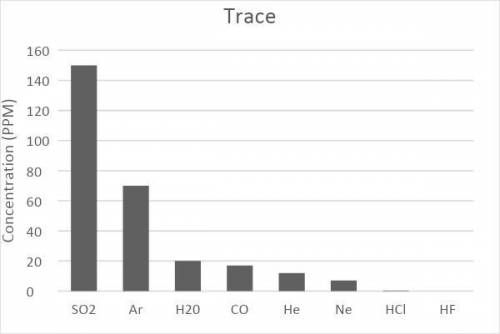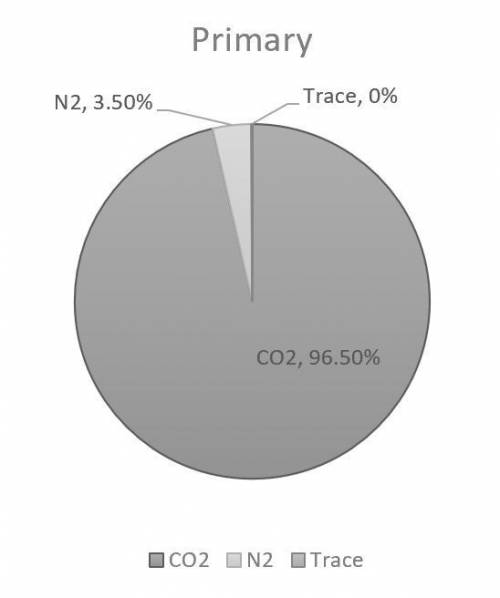
Biology, 17.09.2021 14:00 tdyson3p6xvtu
Venus is known for having a hot, acidic atmosphere inhospitable to human life. The temperature of Venus can reach over 400 degrees Celsius, and the air pressure on the surface of Venus is equivalent to being 900m underwater on Earth.
The characteristics and composition of the atmosphere on Venus is not uniform but varies based on altitude and position on the planet.
Figure 1: Graph depicting the average change in Temperature and Pressure at different levels of altitude from the surface of Venus. Note: 0C = 273K, 100C = 373K. One bar is equal to the average atmospheric pressure at sea level on Earth.
Figure 2: Graph depicting the abundance in PPM of trace molecules in Venus' atmosphere. All together these make up less than a tenth of a percent of the atmosphere.
Figure 3: Chart depicting the percent abundance of gasses in Venus' atmosphere.
Hypotheses suggest that if microbial life were to exist on Venus, it could only exist within the upper atmosphere.
a. Identify the altitude range on Venus where liquid water may be present. Describe one property of water that would contribute to microbial life in Venus' atmosphere.
b. Make a claim about which macromolecules could and could NOT form in Venus' atmosphere. Justify your response.
c. Identify ONE element that would limit the abundance of the molecule(s) that COULD exist.
d. Describe the process where polymers of the molecule(s) identified in (b) are broken down into monomers.
Please help!!




Answers: 1
Another question on Biology

Biology, 21.06.2019 13:30
If you were given a map of the sensory cortex in the postcentral gyrus of the cerebrum, do you think the map would have more “space” devoted to the regions of the body that have the highest density of sensory receptors, or the regions of the body that have the lowest density of sensory receptors? explain
Answers: 2

Biology, 22.06.2019 02:00
Despite the differences in mature plant cells, all of them are derived from meristem cells. the three major types of tissue systems develop from the meristem. meristems develop cells in all but which tissue?
Answers: 3

Biology, 22.06.2019 04:30
Which would be the most useful source of evidence to support mcneill's contention?
Answers: 3

Biology, 22.06.2019 06:20
All organisms contribute some water to the water cycle by conducting
Answers: 1
You know the right answer?
Venus is known for having a hot, acidic atmosphere inhospitable to human life. The temperature of Ve...
Questions

Mathematics, 02.06.2021 04:30

Mathematics, 02.06.2021 04:30


Mathematics, 02.06.2021 04:40

English, 02.06.2021 04:40



Biology, 02.06.2021 04:40

Mathematics, 02.06.2021 04:40



Mathematics, 02.06.2021 04:40


Mathematics, 02.06.2021 04:40

English, 02.06.2021 04:40

Business, 02.06.2021 04:40

Mathematics, 02.06.2021 04:40

Mathematics, 02.06.2021 04:40




